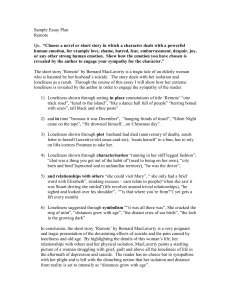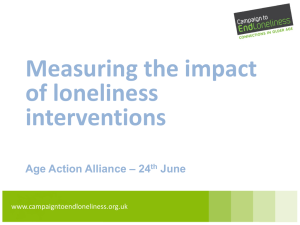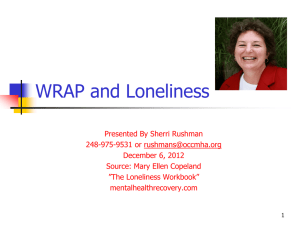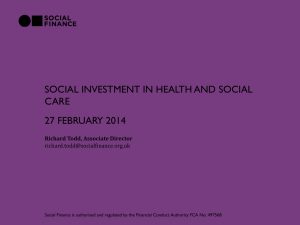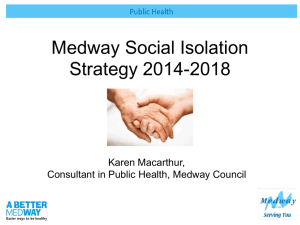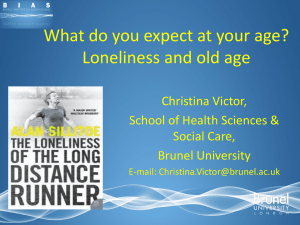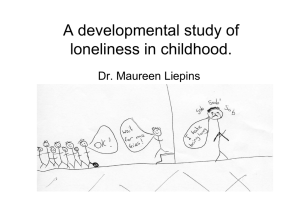Social Isolation in Older People - Presentation 1
advertisement
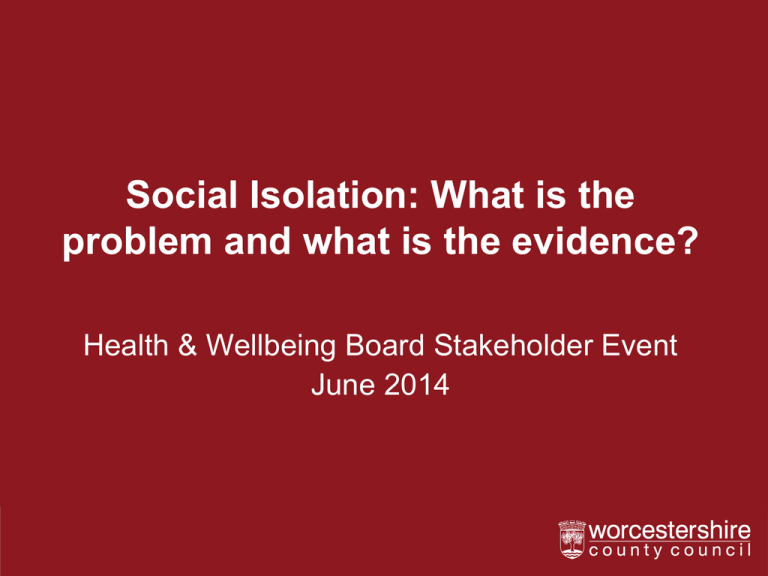
Social Isolation: What is the problem and what is the evidence? Health & Wellbeing Board Stakeholder Event June 2014 Isolation & Loneliness • The terms ‘isolation’ and loneliness are often used interchangeably, but they refer to two distinct concepts. • Isolation • Separation from social or familial contact, community involvement or access to services • Loneliness • An individual’s personal, subjective sense of lacking these things to the extent that they are wanted or needed Risk Factors • Factors related to personal circumstances • E.g. people who are widowed or have no children • Life events • E.g. bereavement or having to move into residential care • Poor physical and mental health • (And expectation of future poor health) Key Facts • Nearly half of all people aged 75 or over live alone • 6% of older people leave their house once a week or less • 17% of older people have less than weekly contact with family, friends or neighbours Age UK; Later life in rural England, More facts and figures • Between 6% and 13% of older people say they feel always or very lonely (Victor, 2011) • If approximately 10% of the population aged over 65 is chronically lonely, this equates to about 11,500 people in Worcestershire (ONS, 2012) • Almost 5 million older people say that the television is their main form of company (Harrop and Jopling, 2009) More facts and figures • 63% of adults aged 52 or over who have been widowed, and 51% of the same group who are separated or divorced report, feeling lonely some of the time or often (Beaumont, 2013 • 59% of adults aged over 52 who report poor health say they feel lonely some of the time or often, compared to 21% who say they are in excellent health (Beaumont, 2013) • A higher percentage of women than men report feeling lonely some of the time or often (Beaumont, 2013) Campaign to end loneliness Risk Factors for Loneliness • Personal • • • • • • • • Poor health Sensory loss Loss of mobility Lower income Bereavement Retirement Becoming a carer Other changes (E.g. giving up driving) • Wider society • Lack of public transport • Physical environment (E.g. no public toilets or benches) • Housing • • • • Fear of crime High population turnover Demographics Technological changes The Impact of Loneliness “Individuals who are socially isolated are between two and five times more likely than those who have strong social ties to die prematurely.” Marmot M. (2010). Fair society, healthy lives, The Marmot Review The Impact of Loneliness - biological • People are less likely to engage in safe behaviours if isolated • Loneliness makes it harder for people to regulate risky behaviours • E.g. Smoking, drinking, over eating • Loneliness also creates changes in the brain which can exacerbate or precipitate ill-health. • Loneliness can result in physical changes that increase risk of heart disease, high blood pressure and stroke The Impact of Loneliness - mental health • Depression affects 1 in 5 older people living in the community and 2 in 5 in care homes • Lonely individuals are more prone to depression • This has been show to be causal • The more lonely someone is the more likely they are to experience depressive symptoms • Loneliness affects cognition • Lonely people become more vigilant for threats and focussed on self-preservation • They can become less attentive to others’ feelings • They exaggerate negative and positive interactions • All this can impact relationships The Impact of Loneliness - mortality • A meta-analysis of 148 studies of social relationships and mortality • 50% increase in survival for those with strong social connections after an average of 7½ years. • Having weak social connections carries a health risk: • Equivalent to smoking 15 cigarettes a day • Equivalent to being an alcoholic • More harmful than not exercising • Twice as harmful as obesity • These correlations are likely to be greater for social connections if the positive effects of relationships were isolated. The Impact of Loneliness – Quality of Life • New quality of life measure developed by Bowling based on research into needs and aspirations looking at • • • • • Social and family relationships Social roles and activities Health and functional ability (enablers) Home and neighbourhood (perceived social capital) Psychological well-being and outlook (life satisfaction, contentment, optimism, social comparisons) • Income • Independence and being in control of one’s own life • Religion, culture and children • Social relationships were ranked as the key dimension of quality of life Types of Intervention • One-to-One – befriending, mentoring • Group services – day centres, social events • Community engagement – encouraging participation; choirs, time banks, Examples of Good Practice in Worcestershire • Ageing Well Befriending Project - Malvern Hills • Launched October 2013 • 50 clients have been identified and referred • Additional 10 receiving regular care calls • 37 volunteers 15 Examples of Good Practice in Worcestershire • Ageing well in Worcester City - Onside Advocacy • Increase identification of isolated 50+ • Increase access to assessment, information and guidance for isolated 50+ to assist them to access health, care and support services they need or desire, including social or community support • Increased levels of mental wellbeing and physical health 16 Other Examples of good practice in Worcestershire • Village agents schemes connecting people with local services. • Voluntary sector offering visiting services into people's homes, such as Wellcheck which connect people with supportive services. • Showcase of services for older people. • Community Wellbeing interventions- training programmes, meals, foot care • And many more... Examples of good practice • Village Agents • Social prescribing - improving mental health outcomes; improving community well-being and reducing social exclusion (Friedli and Watson, 2004) • 17% of older people have less than weekly contact with family, friends or neighbours Examples of good practice • The Zimmers • The oldest rock band in the UK! Examples of good practice • LinkAge Bristol • Walking group; coffee morning; lunch club; film club; tai chi; line dancing; gentle exercise; singing; arts and crafts; computer classes • www.linkagebristol.org.uk • • • • • Costs £350,000 a year 15 staff 200 volunteers 3,000+ older people impacted, 600 over 85 For every £1 spent social return on investment estimated to be £1.20 Toolkit for health and wellbeing Boards www.campaigntoendloneliness.org.uk/toolkit 21 Cost-effectiveness • Befriending services • Cost about £80 per year per person • £35 savings in first year • Including quality of life improvements saving approximately £300 per year • Economic benefits of community navigator even greater • Older individuals in group activities • Cost of health service use per person in the group €1,522 per year compared to €2,465 in control group • Cost of intervention was €62 per person per year
